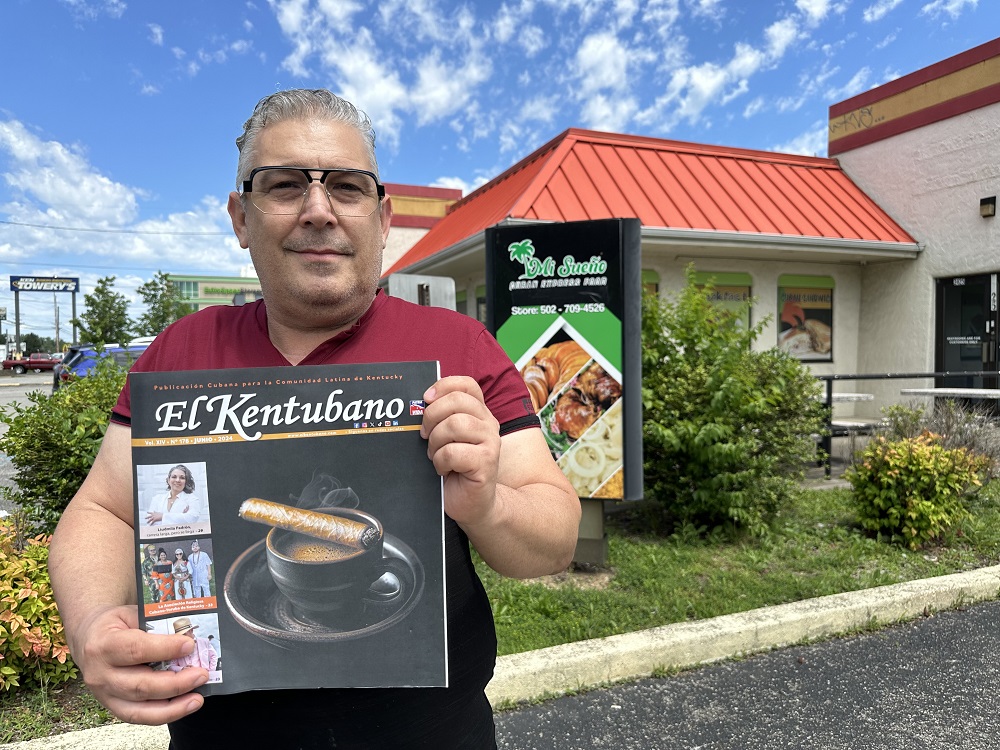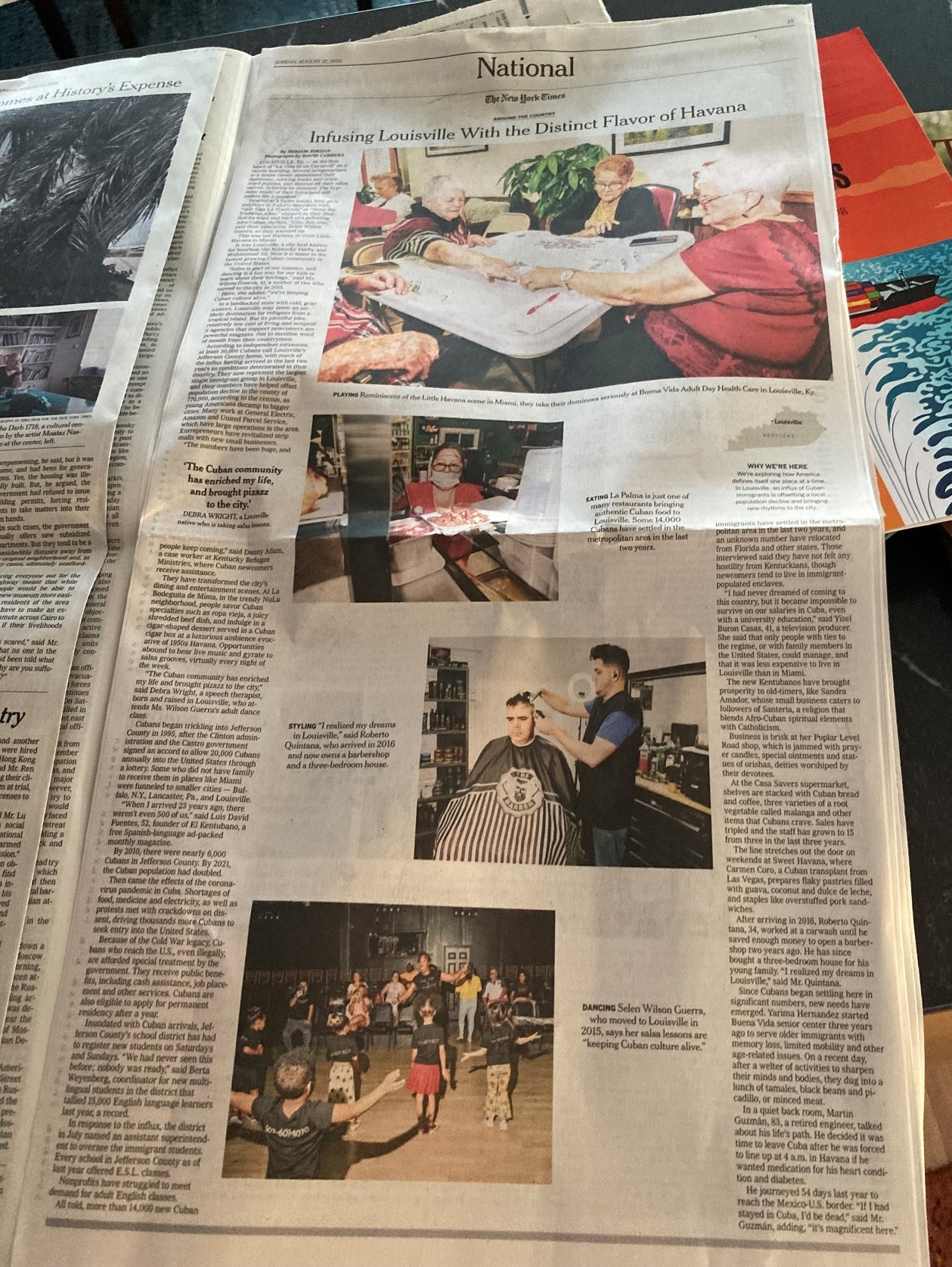The New York Times se hace eco del fenómeno cubano en Louisville, KY
En sus ediciones digital e impresa de domingo, el periódico The New York Times se hizo eco de la comunidad cubana de Kentucky. Reproducimos aquí su cobertura completa (en inglés).
The New Little Havana: Why Cuban Migrants Are Moving to Kentucky
Louisville, best known for bourbon, the Kentucky Derby and Muhammad Ali, is now home to the fastest-growing Cuban community in the country.

By Miriam Jordan; Photographs by David Cabrera. Reporting from Louisville, Ky. Aug. 26, 2023
At the first beats of “La Vida es un Carnaval” on a recent morning, several octogenarians in a senior center abandoned their dominoes, coloring books and crossword puzzles, and showed off their salsa moves. Arthritis be damned. The hypnotic music of their homeland still made life a carnival.
Nearby, at a ballet studio, little girls and boys in T-shirts inscribed with, “Que Siga La Tradicion,” or “Keep the Tradition Alive,” clapped as they shuffled forward and back to a pulsating Afro-Cuban rhythm. “Uno, dos, tres,” said their instructor, Selen Wilson Guerra, as she warmed them up for class.
This was not Havana, or even Little Havana in Miami.
It was Louisville, a city best known for bourbon, the Kentucky Derby and Muhammad Ali. Now it is home to the fastest growing Cuban community in the United States.



“Salsa is part of our essence, and dancing is a fun way for our kids to learn about their heritage,” said Ms. Wilson Guerra, 41, a mother of two who moved to the city in 2015.
Here, she added, “we’re keeping Cuban culture alive.”
In a landlocked state with cold, gray winters, Louisville may seem an unlikely destination for refugees from a tropical island. But its plentiful jobs, relatively low cost of living and nonprofit agencies that support newcomers are powerful magnets. Not to mention word of mouth from longtime Cuban residents.
According to independent estimates, at least 30,000 Cubans call Louisville’s Jefferson County home, with much of the influx having arrived in the last two years as conditions deteriorated in their country. They now represent the largest single immigrant group in Louisville, and their numbers, which continue to swell, have helped offset population decline in the county of 770,000, according to the Census, as young Americans decamp to bigger cities. Many work at General Electric, Amazon and United Parcel Service, which have large operations in the area. The entrepreneurs among them have revitalized strip malls with new small businesses.
“The numbers have been huge, and people keep coming,” said Danny Adam, a case worker at Kentucky Refugee Ministries, where Cuban newcomers receive assistance.



The line stretches out the door on weekends at Sweet Havana.
They have transformed the city’s dining and entertainment scenes. At La Bodeguita de Mima, in the trendy NuLu neighborhood, foodies savor Cuban specialties such as ropa vieja, a juicy shredded beef dish, and indulge in a cigar-shaped dessert served in a Cuban cigar box at a luxurious ambience evocative of 1950s Havana. Opportunities abound to hear live music and gyrate to salsa grooves, virtually every night of the week.
“The Cuban community has enriched my life and brought pizazz to the city,” said Debra Wright, a speech therapist, born and raised in Louisville, who attends Ms. Wilson Guerra’s adult dance class.
Cubans began trickling into Jefferson County in 1995, after the Clinton administration and the Castro government signed an accord to allow 20,000 Cubans annually into the United States through a lottery. Some of the winners, who did not have family to receive them in places like Miami, were funneled to smaller cities — Buffalo, N.Y., Lancaster, Pa., and Louisville.
“When I arrived 23 years ago, there weren’t even 500 of us,” said Luis David Fuentes, 52, founder of “El Kentubano,” a free Spanish-language ad-packed monthly magazine.
By 2010, there were nearly 6,000 Cubans in Jefferson County. By 2021, the Cuban population had doubled.
Then came the effects of the coronavirus pandemic in Cuba. Shortages of food, medicine and electricity, as well as protests met with crackdowns on dissent, driving thousands more Cubans to seek entry into the United States.



Because of the Cold War legacy, Cubans who reach the United States, even illegally, are afforded special treatment by the government, unlike migrants from most countries. They receive public benefits, including cash assistance, job placement and other services. Cubans are also eligible to apply for permanent residency after a year.
Inundated with Cuban arrivals, Jefferson County’s school district has had to register new students on Saturdays and Sundays. “We had never seen this before; nobody was ready,” said Berta Weyenberg, coordinator for new multilingual students in the district that tallied 15,000 English language learners last year, a record.
In response to the influx, the district in July named an assistant superintendent to oversee the immigrant students. Every school in Jefferson County as of last year offered ESL classes.
Nonprofits have struggled to meet demand for adult English classes.
All told, more than 14,000 new Cuban immigrants have settled in the metropolitan area in the last two years, and an unknown number have relocated from Florida and other states where they had been living. Those interviewed by The New York Times said they have not felt any hostility from Kentuckians, though newcomers tend to live in immigrant-populated enclaves.



“I had never dreamed of coming to this country, but it became impossible to survive on our salaries in Cuba, even with a university education,” said Yisel Buron Casas, 41, a television producer. She said that only people with ties to the regime, or with family members in the United States, could manage, and that it was less expensive to live in Louisville than in Miami.
The new “Kentubanos” have brought prosperity to old-timers, like Sandra Amador, whose small business caters to followers of Santeria, a religion that blends Afro-Cuban spiritual elements with Catholicism.
Business is brisk at her Poplar Level Road shop, which is jammed with prayer candles, special ointments and statues of orishas, deities worshiped by their devotees.
At Casa Savers, a supermarket where shelves are stacked with Cuban bread and coffee, three varieties of a root vegetable called malanga, and other items that Cubans crave, sales have tripled and the staff has grown to 15 from three in the last three years.
The line stretches out the door on weekends at Sweet Havana, where Carmen Coro, a Cuban transplant from Las Vegas, prepares flaky pastries filled with guava, coconut and dulce de leche, and staples like overstuffed pork sandwiches.
After arriving in 2016, Roberto Quintana, 34, worked at a carwash until he saved enough money to open a barbershop two years ago. He has since bought a three-bedroom house for his young family. “I realized my dreams in Louisville,” said Mr. Quintana, trimming a customer’s sideburns.Since Cubans began settling here in significant numbers, new needs have emerged. Yarima Hernandez started Buena Vida — the senior center where residents were salsa dancing — three years ago to serve older immigrants with memory loss, limited mobility and other age-related health issues. On a recent day, after a welter of activities to sharpen their minds and bodies, they dug into a lunch of tamales, black beans and picadillo, or minced meat.

In a quiet back room, Martin Guzmán, 83, a retired engineer, talked about his life’s path. He decided it was time to leave Cuba after he was forced to line up at 4 a.m. in Havana if he wanted medication for his heart condition and diabetes.

After journeying 54 days last year, he reached the Mexico-U.S. border. “If I had stayed in Cuba, I’d be dead,” said Mr. Guzmán, adding, “it’s magnificent here.”

Miriam Jordan reports from the grassroots perspective on immigrants and their impact on the demographics, society and economy of the United States. Before joining The Times, she covered immigration at the Wall Street Journal and was a correspondent in Brazil, India, Hong Kong and Israel. More about Miriam Jordan
Enlace original aquí:











